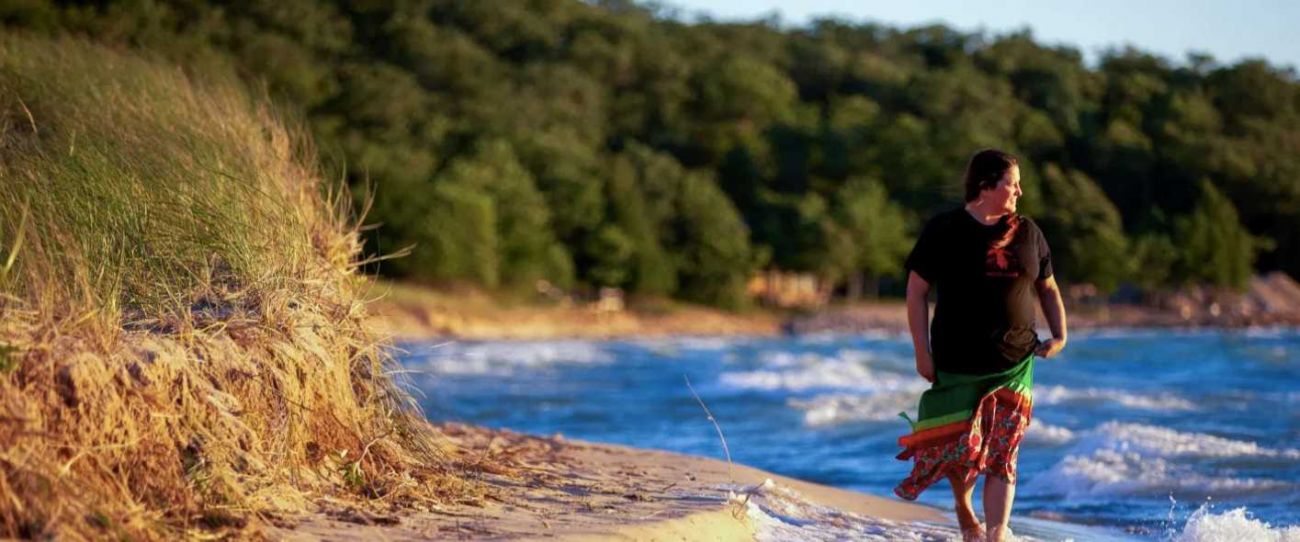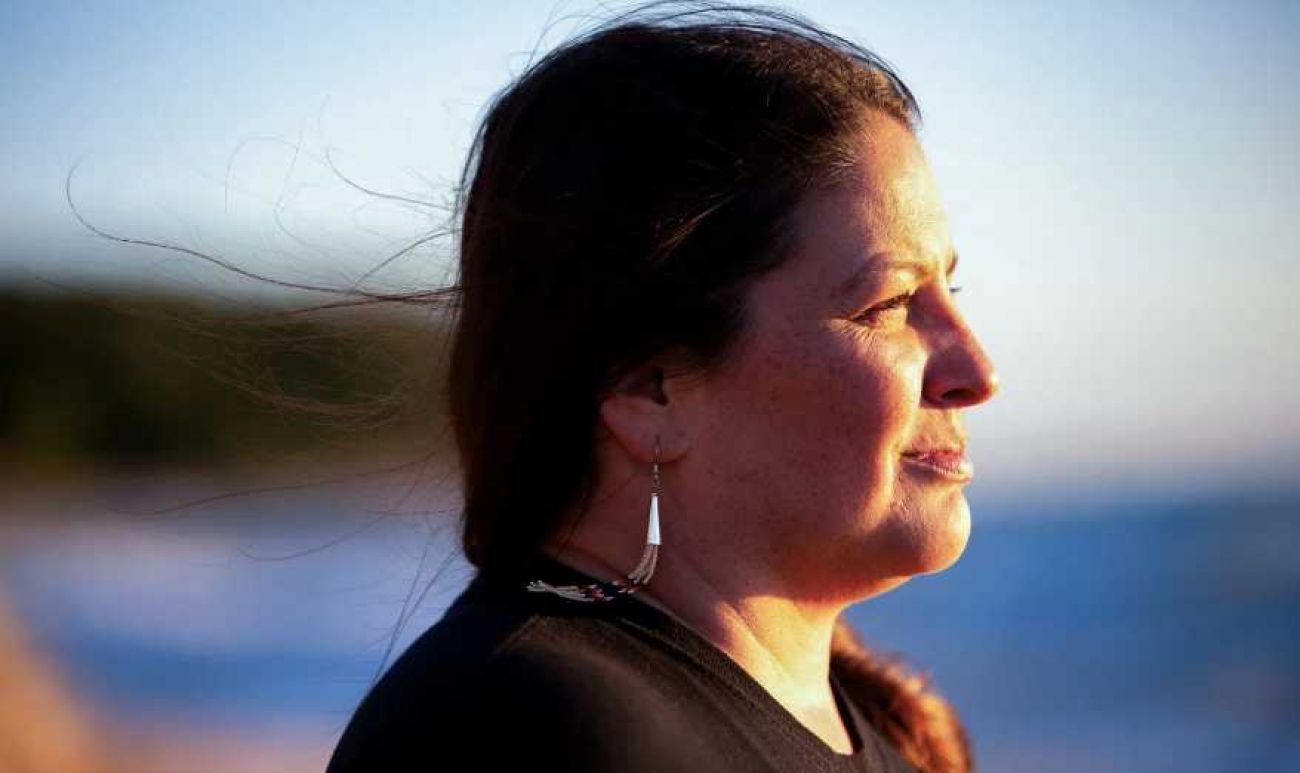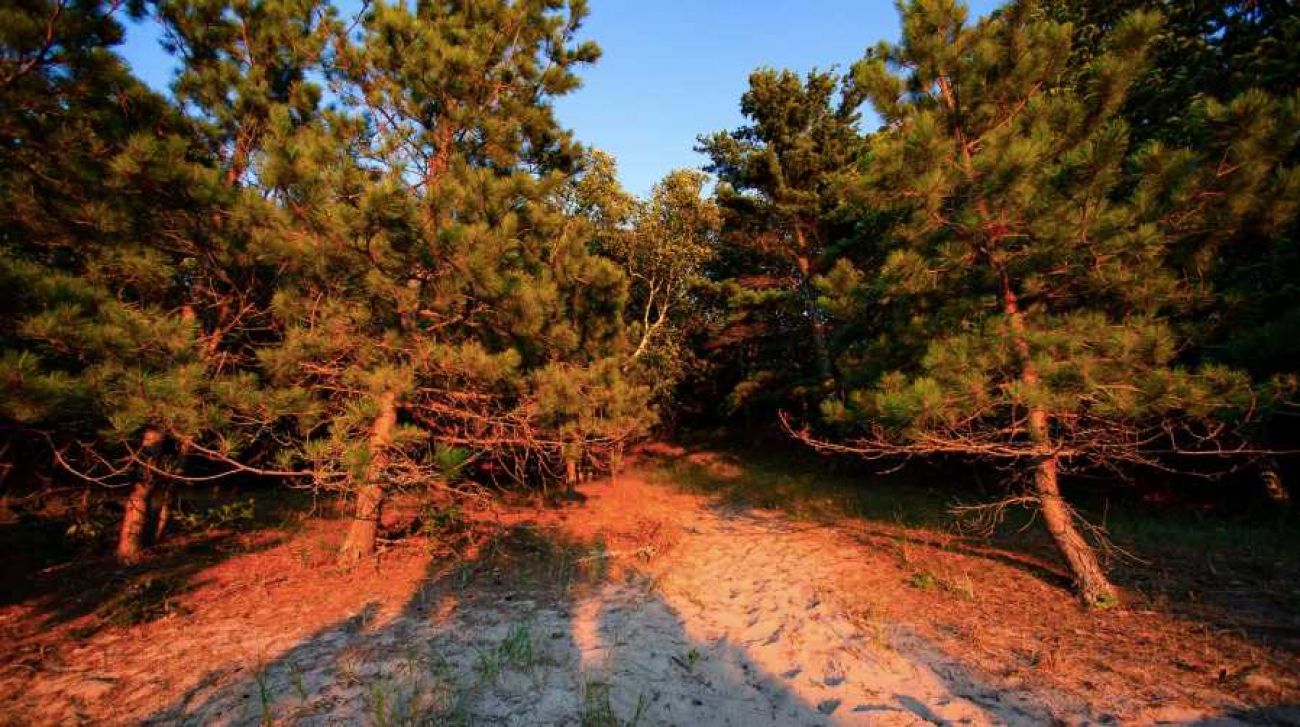In Michigan, rising lake levels disturb sacred ground

At the shoreline, between lake and land, Melissa Wiatrolik reflects on those who were here before Michigan became Michigan. She had been raised in a community that honored the dead, that understood that their ancestors were always present. As a child, she had watched her own family clean the gravestones of those before her. She had attended ghost suppers to both celebrate and feed the deceased. She had grown up with remembrance, and now, at the shores of Lake Michigan, Wiatrolik worked to keep her ancestors at peace.
Indigenous burial grounds line the Michigan coast. But centuries after the ceremonies that put the dead to rest, their physical remains are making their way back to the people. Each of the five Great Lakes broke monthly high-water records in the last two years, an upwelling that has scoured beaches and bluffs. Erosion from high water levels is not just endangering public infrastructure and private property. Along with a burst of lakeshore construction, it is also pulling up the bones that have long been buried.
“Just this year, the National Park Service from the Sleeping Bear Dunes contacted me due to the erosion down there,” Wiatrolik told Circle of Blue. “There was an ancestor bone found by one of the visitors and they were able to bring it to the office. Good Samaritans, because that does not usually happen. People usually throw it off the side, or throw it in the water. Or keep it.”
Wiatrolik belongs to the Little Traverse Bay Bands of Odawa Indians, one of three federally recognized Odawa Tribes in Michigan. The reservation, on the northern end of the Lower Peninsula, spans 336 square miles of Charlevoix and Emmet counties, with tribal offices in the lakeside town of Harbor Springs. Wiatrolik has worked for the tribe for almost two decades, but for the last three years she dedicated her time to the past and present as the tribe’s historic preservation officer for the Native American Graves Protection and Repatriation Act, or NAGPRA.
For Wiatrolik, receiving a call about Odawa remains was not new. Not by a long shot.
NAGPRA, signed into law by President George H. W. Bush in 1990, required federal agencies and institutions to return Indigenous cultural items back to the tribes. This includes sacred and funerary objects, items of cultural patrimony, and human remains. Many were held far away, in museum collections. But then in the late 1990s, the Little Traverse Bay Bands of Odawa Indians began receiving calls about certain “situations.”
“Our strategy at the time was to get the remains that were in museums, that were in boxes in museums,” Eric Hemenway said. “While we were doing that, we were doing a lot of media outreach and people started contacting us. They didn’t know the tribe was a resource for this. [People] would call our office and say, ‘Hey we have this situation on our property, or this thing.’ They’d never say it outright, but we’d know.”
Hemenway grew up in Cross Village, a Michigan coastal town within the Odawa Reservation. He did repatriation work for seven years, beginning in 2006. Now he works as the director of archives/records and educates communities in the region about Odawa remains.
“We’ve been here a really long time,” Hemenway continued. “You’re going to start discovering us if the earth is being moved or revealed.”
And for the past decade, shoreline erosion has been doing just that.

Shifting shorelines, rising waters
The Great Lakes are large enough to behave like small inland seas, but not big enough to ebb and flow twice a day like the oceans. Over the course of decades, the lakes have fluctuated by around six feet. Whenever the levels are really high, like they are now, the erosion of the land can become intense.
“We went through an unusually long period of low water from the late 1980s to the early 2000s, and since then they have shot up dramatically,” Richard Norton told Circle of Blue.
Norton is a professor of urban and regional planning at the University of Michigan. He most recently focused on the challenges of managing Great Lakes shorelines.
“[The levels] reflect the high and aggressive erosion that is taking place right now,” Norton continued. “In most of Lake Michigan, especially in the Southwest, it’s mostly a sandy, gravelly bedrock base. So those shorelines really start to erode away when the lake comes back up. It’s happening now in a big way.”
For the Little Traverse Bay Bands of Odawa Indians, these levels of erosion are revealing their ancestors bit by bit. Wiatrolik continuously gets calls from the areas of Good Hart and Middle Village. Then there was the case in Sleeping Bear Dunes National Lakeshore earlier this year when someone called the National Parks Service, which alerted the tribe.
Sometimes there isn’t even a call. The remains were left at their offices, just discarded at a desk in a shoe box. Usually around lunchtime, Hemenway said — when the people know the staff are probably out on break. There’s some shame or guilt that comes with admitting people kept Indigenous remains, he said.
A big indicator of tribal remains is location. If it’s close to the shoreline, or by a mound, it’s incredibly likely the bones are ancestors of the Odawa, Hemenway said. The Odawa traditionally selected burial sites along the shoreline. The people originally followed seasonal migration routes, moving from the Upper Peninsula to the southern areas of Michigan in the fall, and back again in the spring. When European settlers arrived in the late 17th century, Indigenous people halted their migration and began a new way of life, either establishing their own businesses or working for the settlers.
After the 1836 Treaty of Washington and the 1855 Treaties of Detroit – in which the United States claimed 37 percent of Michigan’s current area from the Odawa for promised benefits that were never delivered – the Europeans began building close to the shorelines and the Odawa buried their deceased further from the water, their ancestors now lying beneath new property.
Even when the tribe does receive a call about uncovered remains, they’ll tell the people to head the police first – to see if there’s a missing person alert or anything out of the ordinary. The tribe can’t prove without a doubt the remains are Odawa, but the location evidence is important. Non-natives are buried in cemeteries, in coffins. Before the settlers arrived, the Odawa burials were all by the water.

Recovering the sacred
Hemenway had spoken with tribal elders about his work before he began repatriation in 2006. He had asked permission to move the bodies and what to do when remains were brought to the offices. But he wanted to understand more. Why were the remains turning up along the shore? One elder had explained to him that water is sacred, a great journey to the other side. We have to cross these bodies of water and our ancestors should be close to the water to make their final journey, the elder had explained. We always want to be close to our home and to our power.
Now many of the remains find a new home at a designated burial area farther inland, on tribal land. The area is undisclosed, a place far from anyone looking to dig up old “relics.”
The Odawa have a long and storied history with grave robbers. Newspapers in the late 1800s in towns such as Harbor Springs would advertise where to find “Indian relics.” The write-up would describe how someone could meet an expert who would take them along the shore to find relics, trinkets, and goods from the chiefs. Hemenway called these forays “organized grave robbing,” and digging up their ancestors became a tourist attraction. There was a fascination with Native skulls, he said. People would dig them up as a treasure, selling them for four or five dollars at the market.
“It’s bittersweet sometimes, I think,” Hemenway explained. “You’re glad the family is finally coming forward and saying ‘My dad did this, I’m so sorry.’ Resolve it. And that’s a good thing, that they’re not hanging onto them anymore, but at the same time. Why did this ever occur?”
Discovering ancestral remains is painful for the tribe. For Hemenway and Wiatrolik, the experience is draining. Sometimes the bones are a child’s, other times they are just fragments. People might think the bones are an animal’s, kicking them around or tossing them far out into the lake.
As more and more property is built along the shorelines of Lake Michigan, a lot of Wiatrolik’s work is mapping erosion areas and monitoring new construction sites to catch the remains before they are thrown away. Often the properties are on private land and peeking in on a site can lead to confrontation. Homeowners don’t always understand the tribe’s role, and they fear finding remains will halt construction or jeopardize the property right.
Wiatrolik recalled one situation in which a property owner approached her and said she had no business being on the construction site. She had to call the State Historic Preservation Office – a department the tribe has good relations with – and ask what to do, what are the rules here? Another time, the preservation officer before Wiatrolik discovered a burial at a construction site. The landowner allowed him to retrieve the bones, but after a couple days told the officer he wanted him out immediately.
A lot of these situations come down to education and awareness, Hemenway noted. The people who live and build in the area often have a better understanding of the burial grounds than vacationers. Summer and spring, when there is new construction and plenty of travelers, are the busiest times for the tribe when it comes to the remains.
To Hemenway, the erosion and the exposure of remains is inevitable and uncontrollable. What they can manage is educating shoreline communities and highlighting the tribe as a resource. The Great Lakes will continue its natural process, ebbing from high levels to low.
Yet, climate scientists note that the extremes might get more extreme, and the cycle might speed up.
“It’s not likely we’re going to have another one of these really long periods of low water, where the erosion slows down,” Norton explained. “Which means over the long term, we’re probably going to see more erosion because it’s during these high periods when the erosion is most aggressive and effective.”
Some homes along the lake now desperately want to put in seawalls to protect their beach properties. Hardening the shoreline is counterproductive, Norton said. It will stop the natural lake process. The sand needs to move onshore and offshore, especially in places with erosion. Ultimately, seawalls, groins, or revetments will kill natural beaches by blocking the sand.
Hardening in one place also creates a rebound effect, deflecting wave energy outward. Areas around the seawalls would exacerbate erosion along neighboring properties, causing more damage than good for the beach.
The best anyone can do is stop building and move away from the shores, Norton said. A lot of people understand the issue, but they’re stubborn. They don’t want to leave.
For Wiatrolik, it’s always painful to watch people continually build on their burial grounds erosion or not. It’s a human rights issue to the tribe. All deceased should have a peaceful place to lie. If property owners find remains along the shore, don’t knock them around. Our ancestors deserve rest, she said.
Circle of Blue unites classic journalism, data literacy and transformative connectivity to report on the growing competition between water, food and energy in a changing climate. Its visionary work across the Great Lakes, U.S., China, Australia, Mexico, India and the Middle East earned the Rockefeller Centennial Innovation Award, one of the nation’s top honors. Bridge Michigan is republishing this article with Circle of Blue's permission.
Michigan Environment Watch
Michigan Environment Watch examines how public policy, industry, and other factors interact with the state’s trove of natural resources.
- See full coverage
- Subscribe
- Share tips and questions with Bridge environment reporter Kelly House
Michigan Environment Watch is made possible by generous financial support from:
Our generous Environment Watch underwriters encourage Bridge Michigan readers to also support civic journalism by becoming Bridge members. Please consider joining today.
See what new members are saying about why they donated to Bridge Michigan:
- “In order for this information to be accurate and unbiased it must be underwritten by its readers, not by special interests.” - Larry S.
- “Not many other media sources report on the topics Bridge does.” - Susan B.
- “Your journalism is outstanding and rare these days.” - Mark S.
If you want to ensure the future of nonpartisan, nonprofit Michigan journalism, please become a member today. You, too, will be asked why you donated and maybe we'll feature your quote next time!



